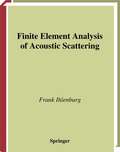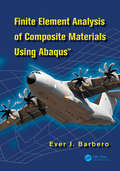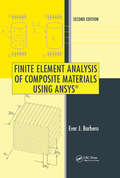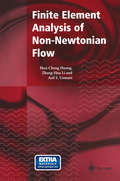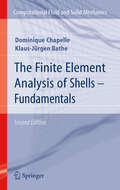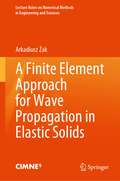- Table View
- List View
Finite Element Analysis of Acoustic Scattering (Applied Mathematical Sciences #132)
by Frank IhlenburgA cognitive journey towards the reliable simulation of scattering problems using finite element methods, with the pre-asymptotic analysis of Galerkin FEM for the Helmholtz equation with moderate and large wave number forming the core of this book. Starting from the basic physical assumptions, the author methodically develops both the strong and weak forms of the governing equations, while the main chapter on finite element analysis is preceded by a systematic treatment of Galerkin methods for indefinite sesquilinear forms. In the final chapter, three dimensional computational simulations are presented and compared with experimental data. The author also includes broad reference material on numerical methods for the Helmholtz equation in unbounded domains, including Dirichlet-to-Neumann methods, absorbing boundary conditions, infinite elements and the perfectly matched layer. A self-contained and easily readable work.
Finite Element Analysis of Antennas and Arrays (Wiley - IEEE)
by Jian-Ming Jin Douglas J. RileyThe Most Complete, Up-to-Date Coverage of the Finite Element Analysis and Modeling of Antennas and Arrays Aimed at researchers as well as practical engineers—and packed with over 200 illustrations including twenty-two color plates—Finite Element Analysis of Antennas and Arrays presents: Time- and frequency-domain formulations and mesh truncation techniques Antenna source modeling and parameter calculation Modeling of complex materials and fine geometrical details Analysis and modeling of narrowband and broadband antennas Analysis and modeling of infinite and finite phased-array antennas Analysis and modeling of antenna and platform interactions Recognizing the strengths of other numerical methods, this book goes beyond the finite element method and covers hybrid techniques that combine the finite element method with the finite difference time-domain method, the method of moments, and the high-frequency asymptotic methods to efficiently deal with a variety of complex antenna problems. Complemented with numerous examples, this cutting-edge resource fully demonstrates the power and capabilities of the finite element analysis and its many practical applications.
Finite Element Analysis of Beam-to-Beam Contact (Lecture Notes in Applied and Computational Mechanics #53)
by Przemyslaw LitewkaPhenomena occurring during a contact of two bodies are encountered in everyday life. In reality almost every type of motion is related to frictional contact between a moving body and a ground. Moreover, modeling of simple and more complex processes as nailing, cutting, vacuum pressing, movement of machines and their elements, rolling or, finally, a numerical simulation of car crash tests, requires taking contact into account. Therefore, its analysis has been a subject of many research efforts for a long time now. However, it is author’s opinion that there are relatively few efforts related to contact between structural elements, like beams, plates or shells. The purpose of this work is to fill this gap. It concerns the beam-to-beam contact as a specific case of the 3D solids contact. A numerical formulation of frictional contact for beams with two shapes of cross-section is derived. Further, a couple of effective methods for modeling of smooth curves representing beam axes are presented. A part of the book is also devoted to analyze some aspects of thermo-electro-mechanical coupling in contact of thermal and electric conductors. Analyses in every chapter are illustrated with numerical examples showing the performance of derived contact finite elements.
Finite Element Analysis of Composite Laminates (Solid Mechanics and Its Applications #7)
by O.O. Ochoa J.N. ReddyComposite materials are increasingly used in aerospace, underwater, and automotive structures. To take advantage of the full potential of composite materials, structural analysts and designers must have accurate mathematical models and design methods at their disposal. The objective of this monograph is to present the laminated plate theories and their finite element models to study the deformation, strength and failure of composite structures. Emphasis is placed on engineering aspects, such as the analytical descriptions, effective analysis tools, modeling of physical features, and evaluation of approaches used to formulate and predict the response of composite structures. The first chapter presents an overview of the text. Chapter 2 is devoted to the introduction of the definitions and terminology used in composite materials and structures. Anisotropic constitutive relations and Iaminate plate theories are also reviewed. Finite element models of laminated composite plates are presented in Chapter 3. Numerical evaluation of element coefficient matrices, post-computation of strains and stresses, and sample examples of laminated plates in bending and vibration are discussed. Chapter 4 introduces damage and failure criteria in composite laminates. Finally, Chapter 5 is dedicated to case studies involving various aspects and types of composite structures. Joints, cutouts, woven composites, environmental effects, postbuckling response and failure of composite laminates are discussed by considering specific examples.
Finite Element Analysis of Composite Materials using Abaqus� (Composite Materials Ser.)
by Ever J. BarberoDeveloped from the author's graduate-level course on advanced mechanics of composite materials, Finite Element Analysis of Composite Materials with Abaqus� shows how powerful finite element tools address practical problems in the structural analysis of composites. Unlike other texts, this one takes the theory to a hands-on level by actually solving
Finite Element Analysis of Composite Materials Using ANSYS (Composite Materials Ser.)
by Ever J. BarberoDesigning structures using composite materials poses unique challenges, especially due to the need for concurrent design of both material and structure. Students are faced with two options: textbooks that teach the theory of advanced mechanics of composites, but lack computational examples of advanced analysis, and books on finite element analysis
Finite Element Analysis of Composite Materials Using ANSYS
by Ever J. BarberoDesigning structures using composite materials poses unique challenges, especially due to the need for concurrent design of both material and structure. Students are faced with two options: textbooks that teach the theory of advanced mechanics of composites, but lack computational examples of advanced analysis, and books on finite element analysis
Finite Element Analysis of Electrical Machines (Power Electronics and Power Systems)
by Sheppard J. SalonIn Finite Element Analysis of Electrical Machines the author covers two-dimensional analysis, emphasizing the use of finite elements to perform the most common calculations required of machine designers and analysts. The book explains what is inside a finite element program, and how the finite element method can be used to determine the behavior of electrical machines. The material is tutorial and includes several completely worked out examples. The main illustrative examples are synchronous and induction machines. The methods described have been used successfully in the design and analysis of most types of rotating and linear machines. Audience: A valuable reference source for academic researchers, practitioners and designers of electrical machinery.
Finite Element Analysis of Hyperbolic Cooling Towers (Lecture Notes in Engineering #20)
by Seyyed Mohammed NikuThe analysis of thin shells of revolution in general has always occupied an important place in the theory of structures, and recently the problem of hyperbolic cooling towers has attracted many investigators due to the wide use of such shells in industry. Until the early 1960's these towers were of moderate size, probably not exceeding 76m (250ft) height. In this range, the structural safety and stability were not of primary concern because, the minimum wall thickness and reinforcement were sufficient to provide the required safety. It was not necessary to use very rigorous methods to analyse the problem. The analysis involved the following assumptions, i) flexural stresses were ignored (membrane tneory), ii) The geometry of the shell was assumed to be perfect and to be idealised as a set of straight sided conical frusta, and iii) The boundary conditions at the base were taken to be fixed or continuously hinged with full tangential restraint.
Finite Element Analysis of Non-Newtonian Flow: Theory and Software
by Hou-Cheng Huang Zheng-Hua Li Asif S. UsmaniA follow on from the author's work "Finite Elements in Heat Transfer" which we published 11/94, and which is a powerful CFD programme that will run on a PC. The fluid flow market is larger than the previous, and this package is good value in comparison with other software packages in Computational Fluid Dynamics, which are generally very expensive. The work in general copes with non-Newtonian laminar flow using the finite element method, and some basic theory of the subject is included in the opening chapters of the book.
Finite Element Analysis of Rotating Beams: Physics Based Interpolation (Foundations of Engineering Mechanics)
by Ranjan GanguliThis book addresses the solution of rotating beam free-vibration problems using the finite element method. It provides an introduction to the governing equation of a rotating beam, before outlining the solution procedures using Rayleigh-Ritz, Galerkin and finite element methods. The possibility of improving the convergence of finite element methods through a judicious selection of interpolation functions, which are closer to the problem physics, is also addressed. The book offers a valuable guide for students and researchers working on rotating beam problems – important engineering structures used in helicopter rotors, wind turbines, gas turbines, steam turbines and propellers – and their applications. It can also be used as a textbook for specialized graduate and professional courses on advanced applications of finite element analysis.
The Finite Element Analysis of Shells - Fundamentals (Computational Fluid and Solid Mechanics)
by Dominique Chapelle Klaus-Jurgen BatheThis book presents a modern continuum mechanics and mathematical framework to study shell physical behaviors, and to formulate and evaluate finite element procedures. With a view towards the synergy that results from physical and mathematical understanding, the book focuses on the fundamentals of shell theories, their mathematical bases and finite element discretizations. The complexity of the physical behaviors of shells is analysed, and the difficulties to obtain uniformly optimal finite element procedures are identified and studied. Some modern finite element methods are presented for linear and nonlinear analyses. In this Second Edition the authors give new developments in the field and - to make the book more complete - more explanations throughout the text, an enlarged section on general variational formulations and new sections on 3D-shell models, dynamic analyses, and triangular elements. The analysis of shells represents one of the most challenging fields in all of mechanics, and encompasses various fundamental and generally applicable components. Specifically, the material presented in this book regarding geometric descriptions, tensors and mixed variational formulations is fundamental and widely applicable also in other areas of mechanics.
The Finite Element Analysis of Shells - Fundamentals (Computational Fluid and Solid Mechanics)
by Dominique Chapelle Klaus-Jurgen BatheThe authors present a modern continuum mechanics and mathematical framework to study shell physical behaviors, and to formulate and evaluate finite element procedures. With a view towards the synergy that results from physical and mathematical understanding, the book focuses on the fundamentals of shell theories, their mathematical bases and finite element discretizations. The complexity of the physical behaviors of shells is analysed, and the difficulties to obtain uniformly optimal finite element procedures are identified and studied. Some modern finite element methods are presented for linear and nonlinear analyses. A state of the art monograph by leading experts.
Finite Element Analysis of Solids and Structures
by Sudip S. BhattacharjeeFinite Element Analysis of Solids and Structures combines the theory of elasticity (advanced analytical treatment of stress analysis problems) and finite element methods (numerical details of finite element formulations) into one academic course derived from the author’s teaching, research, and applied work in automotive product development as well as in civil structural analysis. Features Gives equal weight to the theoretical details and FEA software use for problem solution by using finite element software packages Emphasizes understanding the deformation behavior of finite elements that directly affect the quality of actual analysis results Reduces the focus on hand calculation of property matrices, thus freeing up time to do more software experimentation with different FEA formulations Includes chapters dedicated to showing the use of FEA models in engineering assessment for strength, fatigue, and structural vibration properties Features an easy to follow format for guided learning and practice problems to be solved by using FEA software package, and with hand calculations for model validation This textbook contains 12 discrete chapters that can be covered in a single semester university graduate course on finite element analysis methods. It also serves as a reference for practicing engineers working on design assessment and analysis of solids and structures. Teaching ancillaries include a solutions manual (with data files) and lecture slides for adopting professors.
Finite Element Analysis of Solids and Structures
by Sudip S. BhattacharjeeFinite Element Analysis of Solids and Structures combines the theory of elasticity (advanced analytical treatment of stress analysis problems) and finite element methods (numerical details of finite element formulations) into one academic course derived from the author’s teaching, research, and applied work in automotive product development as well as in civil structural analysis. Features Gives equal weight to the theoretical details and FEA software use for problem solution by using finite element software packages Emphasizes understanding the deformation behavior of finite elements that directly affect the quality of actual analysis results Reduces the focus on hand calculation of property matrices, thus freeing up time to do more software experimentation with different FEA formulations Includes chapters dedicated to showing the use of FEA models in engineering assessment for strength, fatigue, and structural vibration properties Features an easy to follow format for guided learning and practice problems to be solved by using FEA software package, and with hand calculations for model validation This textbook contains 12 discrete chapters that can be covered in a single semester university graduate course on finite element analysis methods. It also serves as a reference for practicing engineers working on design assessment and analysis of solids and structures. Teaching ancillaries include a solutions manual (with data files) and lecture slides for adopting professors.
Finite Element Analysis of the Collapse and Post-Collapse Behavior of Steel Pipes: Applications to the Oil Industry (SpringerBriefs in Applied Sciences and Technology)
by Eduardo N Dvorkin Rita G. ToscanoThis book presents a detailed discussion of the models that were developed to simulate the collapse and post-collapse behavior of steel pipes.The finite element method offers to engineers the possibility of developing models to simulate the collapse behavior of casings inside oil wells and the collapse behavior of deepwater pipelines. However, if technological decisions are going to be reached from these model results, with implications for the economic success of industrial operations, for the occupational safety and health and for the environment, the engineering models need to be highly reliable. Using these models engineers can quantify the effect of manufacturing tolerances, wear, corrosion, etc. This book describes in great details the experimental programs that are developed to validate the numerical results.
Finite Element Analysis of Weld Thermal Cycles Using ANSYS
by G. RavichandranFinite Element Analysis of Weld Thermal Cycles Using ANSYS aims at educating a young researcher on the transient analysis of welding thermal cycles using ANSYS. It essentially deals with the methods of calculation of the arc heat in a welded component when the analysis is simplified into either a cross sectional analysis or an in-plane analysis. The book covers five different cases involving different welding processes, component geometry, size of the element and dissimilar material properties. A detailed step by step calculation is presented followed by APDL program listing and output charts from ANSYS. Features: Provides useful background information on welding processes, thermal cycles and finite element method Presents calculation procedure for determining the arc heat input in a cross sectional analysis and an in-plane analysis Enables visualization of the arc heat in a FEM model for various positions of the arc Discusses analysis of advanced cases like dissimilar welding and circumferential welding Includes step by step procedure for running the analysis with typical input APDL program listing and output charts from ANSYS.
Finite Element Analysis of Weld Thermal Cycles Using ANSYS
by G. RavichandranFinite Element Analysis of Weld Thermal Cycles Using ANSYS aims at educating a young researcher on the transient analysis of welding thermal cycles using ANSYS. It essentially deals with the methods of calculation of the arc heat in a welded component when the analysis is simplified into either a cross sectional analysis or an in-plane analysis. The book covers five different cases involving different welding processes, component geometry, size of the element and dissimilar material properties. A detailed step by step calculation is presented followed by APDL program listing and output charts from ANSYS. Features: Provides useful background information on welding processes, thermal cycles and finite element method Presents calculation procedure for determining the arc heat input in a cross sectional analysis and an in-plane analysis Enables visualization of the arc heat in a FEM model for various positions of the arc Discusses analysis of advanced cases like dissimilar welding and circumferential welding Includes step by step procedure for running the analysis with typical input APDL program listing and output charts from ANSYS.
Finite Element Analysis on Badminton Racket Design Parameters (SpringerBriefs in Applied Sciences and Technology)
by Fakhrizal Azmy Nasruddin Muhamad Noor Harun Ardiyansyah Syahrom Mohammed Rafiq Abdul Kadir Abdul Hafidz Omar Andreas ÖchsnerThis work identifies the characteristics of racket design parameters that influence racket performance. It presents the finite element analysis of several designs of badminton rackets and compares them to experimental results for validation. Designing a racket requires a comprehensive understanding of racket performance characteristics. Essentially, racket performance is related to the sweet spot, which is the spot on the racket head that produces the most power and control when it strikes a shuttlecock. Determining a coefficient of restitution can help to identify the sweet spot on a racket. By analyzing several head shape designs, it becomes apparent that isometric head shape rackets produce better coefficients of restitution compared to oval and round ones. It is recommended that the racket design consist of low string tension, stiffer racket shafts and bigger head size in order to produce higher shuttlecock speed.
The Finite Element Analysis Program MSC Marc/Mentat: A First Introduction
by Andreas Öchsner Marco ÖchsnerBased on simple examples, this book offers a short introduction to the general-purpose finite element program MSC Marc, a specialized program for non-linear problems (implicit solver) distributed by the MSC Software Corporation, which is commonly used in academia and industry. Today the documentation of all finite element programs includes a variety of step-by-step examples of differing complexity, and in addition, all software companies offer professional workshops on different topics. As such, rather than competing with these, the book focuses on providing simple examples, often single-element problems, which can easily be related to the theory that is discussed in finite element lectures. This makes it an ideal companion book to classical introductory courses on the finite element method.
Finite Element Analysis with Personal Computers
by Edward R. ChampionThis book addresses the history of finite element analysis (FEA) and why FEA is becoming a necessary tool for the solution of a wide variety of problems encountered in the professsional engineer's career. It helps the user to solve general classes of problems with FEA on personal computers.
Finite Element and Boundary Methods in Structural Acoustics and Vibration
by Noureddine Atalla Franck SgardEffectively Construct Integral Formulations Suitable for Numerical ImplementationFinite Element and Boundary Methods in Structural Acoustics and Vibration provides a unique and in-depth presentation of the finite element method (FEM) and the boundary element method (BEM) in structural acoustics and vibrations. It illustrates the principles using a
Finite Element and Discontinuous Galerkin Methods for Transient Wave Equations (Scientific Computation)
by Gary Cohen Sébastien PernetThis monograph presents numerical methods for solving transient wave equations (i.e. in time domain). More precisely, it provides an overview of continuous and discontinuous finite element methods for these equations, including their implementation in physical models, an extensive description of 2D and 3D elements with different shapes, such as prisms or pyramids, an analysis of the accuracy of the methods and the study of the Maxwell’s system and the important problem of its spurious free approximations. After recalling the classical models, i.e. acoustics, linear elastodynamics and electromagnetism and their variational formulations, the authors present a wide variety of finite elements of different shapes useful for the numerical resolution of wave equations. Then, they focus on the construction of efficient continuous and discontinuous Galerkin methods and study their accuracy by plane wave techniques and a priori error estimates. A chapter is devoted to the Maxwell’s system and the important problem of its spurious-free approximations. Treatment of unbounded domains by Absorbing Boundary Conditions (ABC) and Perfectly Matched Layers (PML) is described and analyzed in a separate chapter. The two last chapters deal with time approximation including local time-stepping and with the study of some complex models, i.e. acoustics in flow, gravity waves and vibrating thin plates. Throughout, emphasis is put on the accuracy and computational efficiency of the methods, with attention brought to their practical aspects.This monograph also covers in details the theoretical foundations and numerical analysis of these methods. As a result, this monograph will be of interest to practitioners, researchers, engineers and graduate students involved in the numerical simulationof waves.
A Finite Element Approach for Wave Propagation in Elastic Solids (Lecture Notes on Numerical Methods in Engineering and Sciences)
by Arkadiusz ŻakThis book focuses on wave propagation phenomena in elastic solids modelled by the use of the finite element method. Although the latter is a well-established and popular numerical tool used by engineers and researchers all around the word the process of modelling of wave propagation can still be a challenge. The book introduces a reader to the problem by presenting a historical background and offering a broad perspective on the development of modern science and numerical methods. The principles of wave phenomena are clearly presented to the reader as well as the necessary background for understanding the finite element method, which is the following chapter of the book is viewed from the modeller point-of-view. Apart from the principles the book also addresses more advanced topics and problems including the use of the spectral-finite element method, the spline-based finite element method as well as the problems of undesired and hidden properties of discrete numerical models.
Finite Element Concepts: A Closed-Form Algebraic Development
by Gautam DasguptaThis text presents a highly original treatment of the fundamentals of FEM, developed using computer algebra, based on undergraduate-level engineering mathematics and the mechanics of solids. The book is divided into two distinct parts of nine chapters and seven appendices. The first chapter reviews the energy concepts in structural mechanics with bar problems, which is continued in the next chapter for truss analysis using Mathematica programs. The Courant and Clough triangular elements for scalar potentials and linear elasticity are covered in chapters three and four, followed by four-node elements. Chapters five and six describe Taig’s isoparametric interpolants and Iron’s patch test. Rayleigh vector modes, which satisfy point-wise equilibrium, are elaborated on in chapter seven along with successful patch tests in the physical (x,y) Cartesian frame. Chapter eight explains point-wise incompressibility and employs (Moore-Penrose) inversion of rectangular matrices. The final chapter analyzes patch-tests in all directions and introduces five-node elements for linear stresses. Curved boundaries and higher order stresses are addressed in closed algebraic form. Appendices give a short introduction to Mathematica, followed by truss analysis using symbolic codes that could be used in all FEM problems to assemble element matrices and solve for all unknowns. All Mathematica codes for theoretical formulations and graphics are included with extensive numerical examples.
